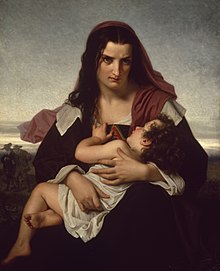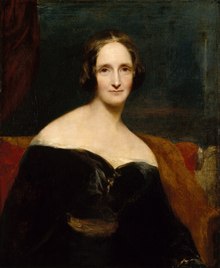19th Century Literature/Printable version
| This is the print version of 19th Century Literature You won't see this message or any elements not part of the book's content when you print or preview this page. |
The current, editable version of this book is available in Wikibooks, the open-content textbooks collection, at
https://en.wikibooks.org/wiki/19th_Century_Literature
Bartleby the Scrivener
Herman Melville - an introduction
[edit | edit source]Herman Melville (1819–1891) was an American writer of essays, short stories and novels. While his early novels enjoyed some success, his later efforts, including the classic Moby Dick and the novel Pierre were poorly received. It is only later on that his work has been rediscovered and celebrated.
Bartleby the Scrivener[edit | edit source]It was on the third day, I think, of his being with me, and before any necessity had arisen for having his own writing examined, that, being much hurried to complete a small affair I had in hand, I abruptly called to Bartleby. In my haste and natural expectancy of instant compliance, I sat with my head bent over the original on my desk, and my right hand sideways, and somewhat nervously extended with the copy, so that immediately upon emerging from his retreat, Bartleby might snatch it and proceed to business without the least delay. In this very attitude did I sit when I called to him, rapidly stating what it was I wanted him to do—namely, to examine a small paper with me. Imagine my surprise, nay, my consternation, when without moving from his privacy, Bartleby in a singularly mild, firm voice, replied, “I would prefer not to.” I sat awhile in perfect silence, rallying my stunned faculties. Immediately it occurred to me that my ears had deceived me, or Bartleby had entirely misunderstood my meaning. I repeated my request in the clearest tone I could assume. But in quite as clear a one came the previous reply, “I would prefer not to.” “Prefer not to,” echoed I, rising in high excitement, and crossing the room with a stride. “What do you mean? Are you moon-struck? I want you to help me compare this sheet here—take it,” and I thrust it towards him. “I would prefer not to,” said he. I looked at him steadfastly. His face was leanly composed; his gray eye dimly calm. Not a wrinkle of agitation rippled him. Had there been the least uneasiness, anger, impatience or impertinence in his manner; in other words, had there been any thing ordinarily human about him, doubtless I should have violently dismissed him from the premises. But as it was, I should have as soon thought of turning my pale plaster-of-paris bust of Cicero out of doors. I stood gazing at him awhile, as he went on with his own writing, and then reseated myself at my desk. This is very strange, thought I. What had one best do? But my business hurried me. I concluded to forget the matter for the present, reserving it for my future leisure. So calling Nippers from the other room, the paper was speedily examined. |
Preliminary Questions to Consider
[edit | edit source]- What type of narrator does Melville use? What is the effect of this in the last paragraph?
- Why does Bartleby continue to reply: 'I would prefer not to.'?
- What does the narrator mean by 'natural expectancy of instant compliance' and how is this challenged?
Text discussion and analysis
[edit | edit source]
The Scarlet Letter
The Scarlet Letter
[edit | edit source]Hawthorne's tale revolves around the life of Hester Prynee after having been forced to wear the mark of an A on her blouse; the A originally stood for Adultery, the crime which Hester committed, yet was later taken to stand for able. Hawthorne is critical of the Puritan morality that he thought was preoccupied with punishing other's sins.
Extract One
[edit | edit source]In this extract, Hawthorne shows us a crowd that waits for Hester Prynne to leave the prison and to make her way to the place where she will be publicly humiliated.
|
"Goodwives," said a hard-featured dame of fifty, "I'll tell ye a piece of my mind. It would be greatly for the public behoof, if we women, being of mature age and church-members in good repute, should have the handling of such malefactresses as this Hester Prynne. What think ye, gossips? If the hussy stood up for judgment before us five, that are now here in a knot together, would she come off with such a sentence as the worshipful magistrates have awarded? Marry, I trow not!" "People say," said another, "that the Reverend Master Dimmesdale, her godly pastor, takes it very grievously to heart that such a scandal should have come upon his congregation." "The magistrates are God-fearing gentlemen, but merciful overmuch,—that is a truth," added a third autumnal matron. "At the very least, they should have put the brand of a hot iron on Hester Prynne's forehead. Madame Hester would have winced at that, I warrant me. But she,—the naughty baggage,—little will she care what they put upon the bodice of her gown! Why, look you, she may cover it with a brooch, or such like, heathenish adornment, and so walk the streets as brave as ever!" "Ah, but," interposed, more softly, a young wife, holding a child by the hand, "let her cover the mark as she will, the pang of it will be always in her heart." "What do we talk of marks and brands, whether on the bodice of her gown, or the flesh of her forehead?" cried another female, the ugliest as well as the most pitiless of these self-constituted judges. "This woman has brought shame upon us all, and ought to die. Is there not law for it? Truly there is, both in the Scripture and the statute-book. Then let the magistrates, who have made it of no effect, thank themselves if their own wives and daughters go astray!" "Mercy on us, goodwife," exclaimed a man in the crowd, "is there no virtue in woman, save what springs from a wholesome fear of the gallows? That is the hardest word yet! Hush, now, gossips; for the lock is turning in the prison-door, and here comes Mistress Prynne herself." |
Explanation and Analysis
[edit | edit source]
Hawthorne's commentary is revealed in this extract through the characterization of the members of the crowd. Consider how the first woman to speak is described - 'a hard-featured dame of fifty'. This is certainly not a flattering description. She asks the crowd to let her 'tell ye a piece of my mind'. Her dialogue is coarse and unforgiving - 'if the hussy stood up for judgement'. She is not only 'hard-featured' but also very judgmental, unforgiving and moralistic. Also notice that the only one to sympathize with young Hester was the young female holding a child by the hand, thus re-emphasizing the rosebush representing a new era and hope for the future compared to the rusting iron door.
Frankenstein
Mary Shelley's Frankenstein was first published in 1818, then later revised into the form we know it as today. One of the most notable differences was the change in Elizabeth's personal history from Victor's cousin to adopted orphan.
For more information on Mary Shelley, a plot summary of Frankenstein and its representation in the media check out their Wikipedia pages.
Narrative Structure
[edit | edit source]
The novel is structured as a frame narrative, opening and concluding with a letter written by Captain Walton, an arctic explorer who comes across Victor on the ice. He claims to be transcribing Victor's story as it is told to him, thus switching to Victor's perspective. Half way through Victor's narrative he describes a meeting with his creation, in which the creature tells his own life history to Victor. As Victor recounts this apparently word for word, we change perspectives again, creating a third layer within the narrative.
In this first sentence of letter one the information is that is read about is that the journey or quest that the speaker was on was successful so far. He is writing to someone who did not have a good insight on how this would end up. He is telling them you will rejoice, be happy because he has accomplished what they thought would be evil.
Characters
[edit | edit source]Victor Frankenstein
[edit | edit source]
Despite what Hollywood might have you believe, Victor is not a wholly evil character. The novel follows him from childhood and shows how his keen interest in science developed from studying ancient texts, in particular concerning alchemy. Science was his passion; he even delayed marrying Elizabeth and left his home to attend university and become a doctor. It is during his anatomy classes that he hits upon an idea that could bring life to dead flesh; just as an alchemist might create gold out of lead.
Despite building his creature out of the parts of executed criminals, Victor is so enamored with his own brilliance that he expects it to be beautiful, and envisions himself to be the god of a new race of people, free from the hardships of disease and aging. Victor always has the best intentions in his actions, but he fails to see his own limitations. When the creature is born hideous, instead of celebrating his success at creating life Victor is appalled and abandons it immediately.
From then on Victor is haunted by his creation. He tries to run from it and shuns it at every opportunity, but when it murders he is forced to confront it. The creature tells a sympathetic story of its abandonment and how being so frightening looking means it can never befriend ordinary people. Having no parent to guide it, the creature also has no morals so Victor fears it - sensing this the creature threatens Victor and commands him to build a female to act as wife to the creature.
About to enter a marriage himself Victor is terrified of what the creature might do to further injure his family. He agonizes over his decision, feeling that to create another creature, although within his power, would be an abomination. Victor is as much disturbed by his own power over nature as by the physical strength of the thing he has created. Ultimately his own moral compass takes over and he destroys the partially made female creature, costing him his own wife and future. In an attempt to right his wrongs against nature, Victor vows he will not rest until he has destroyed the monster he created.
The Creature
[edit | edit source]
The creature that Victor creates has frequently been misrepresented in films as a hulking, mute beast. Although initially abandoned by Victor, the creature learns to speak and read from observing a family teaching their children, watching them through a crack in the wall. Seeing his reflection in a river the creature is traumatized by his disfigured face and knows that he should not approach people. As well as reading the creature also plays an instrument, later telling Victor that his hand remembered the notes.
When Victor recounts the creature's monologue the creature is both articulate and sensitive. He feels keenly the abandonment of Victor, effectively his father, who did not even see fit to give the creature a name. In this, the creature can be seen as a symbol for disenfranchised people who are ignored or shunned by the upper class.
